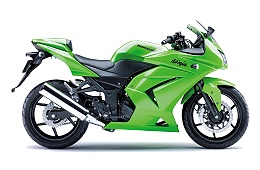Visit the old website: |
Suzuki Hayabusa Stuff:  Tech Specifications Tech Specifications Color Schemes |
Featured story lines: LAMS and Commuter motorcycles Motorcycle Picture Galleries Motorcycle Specs and Pricing |
Honda CBR250R Vs Kawasaki Ninja 250R Comparison
|
|
VS |
|
The Kawasaki Ninja 250R Vs the Honda CBR250R comparison will always be made since both are competitors here and around the world. Both are not true sports motorcycles but sporty looking bikes hiding reasonable mechanicals tuned for reliability more than power.
The differences between the two are immediate. The Ninja 250R instruments are a complete FAIL because they date back to the 1980’s and are not sporty to look at where as the CBR250R is right up to date with a big analogue rev counter with a digital speedo and gauges. (2012 Ninja models have been updated with white backed graphics which look much better but I would feel ripped of if I bought the prior year models) The ride position is good for both and upright. The Kawasaki feels more substantial due to extra width – to accommodate the wider engine. Many will prefer the extra width but everyone will prefer sitting on the Honda because it is a cooler place to be. The overall beauty of both bikes is based on your personal biases but I prefer the CBR250R, it is more modern to look at with slightly higher quality parts. The Ninja is nice too but a little dated and conservative in 2012 as the saying goes – great to look at from a distance just not too closely.
The technical comparison specifically engine power is where every newbie will fail in this comparison. As any Top Gear viewer will know, that there is more to performance than just power and this definitely applies to the CBR250R – because Honda knew what they were doing. Sure the CBR has less power than the Ninja on the spec sheets but if you check out the dyno charts the real power at the rear wheel, there is 2 horsepower down and yet the torque for the CBR is higher than 2! That said both need all the power they can get and more would not go unappreciated. On the road both are different as the CBR peaks early with no flat spots while the Ninja needs 3000rpm more to do the same thing but then hits the flat spot… There’s very little in it overall but I prefer the responsiveness of the CBR.
In terms of riding the Ninja 250R annoys straight away especially when cold with its choke and ease of stalling when cold I did it twice! Once warm you need to turn off the choke too – otherwise you will damage the engine. The need for extra engine revs from stand still to prevent stalling is annoying since I’m used to EFI motorcycles. The CBR works straight off which is excellent very little to complain taking all things into account. The Ninja’s carbeurattors are ancient and need to be replaced. Any one claiming the carbeurattors are better than EFI needs their head checked. The bonus of EFI is that can modify the CBR250R easily by purchasing a PowerCommander unit and plugging in unlike the Ninja which requires major surgery and costs to modify then tune if you can get it right. (Also remember the high revs are part of the 250cc riding experience, important for both motorcycles and part of the fun.)
In the end the Ninja 250R and CBR250R are both great 250cc motorcycles. Both are equal in many ways but in the real world and the long term I think the Honda wins. Once you’ve ridden a superior motorcycle (CBR250R) with new technology is it difficult to go back and this was the case. It’s really up to you which one you want and how much you want to pay but make Kawasaki put in EFI – BEFORE you buy it – so buy the Honda today – I think you’ll be happier in the long run. It’s sad turn of events since the 250 Ninja’s predecessors were some of my favorite 250cc motorcycles. That said, I wouldn’t choose either, I’d spend the extra on the Honda CB400 at the time of writing.
Update August 2012: Breaking news – a more substantial update to the Ninja 250R will most likely be released in 2013 based on news on the Kawasaki Japan website. This confirms my opinion that the current Ninja 205R is indeed underdone.
|
|
||
| Honda CBR250R | Kawasaki Ninja 250R | |
| Engine: | IL1 cylinder 4-stroke 4 valve DOHC (EFI) | IL2 cylinder 4-stroke 4 valve DOHC (Carbs) |
| Capacity: | 249.5cc | 248cc |
| Power/Torque: | 20Kw @ 8,500 RPM 23Nm @ 7000 RPM (Japan) | 29.4Kw @ 11,000 RPM 22Nm @ 9500 RPM |
| Gearbox: | 6 speed | 6 speed |
| Kerb Weight: | 161Kg or 165Kg with ABS | Approx 169Kg |
| Performance: | 0-100kph 8 seconds Approx Max Speed 160Kph Approx |
0-100kph 8 seconds Approx Max Speed 160Kph Approx |
| Fuel Economy: | 13 litre fuel tank Approx 4 litres per 100km |
18 litre fuel tank Under 5 litres per 100km |
| Seat height: | 784mm | 775mm |
| Dimensions: | L2030 x W720 x H1127 x WB1369 | L2085 x W715 x H1110 x WB1400 |
| Recommended Retail Price: | $5490 or $5990 with ABS | $7299 (See above) |
|
|
||


